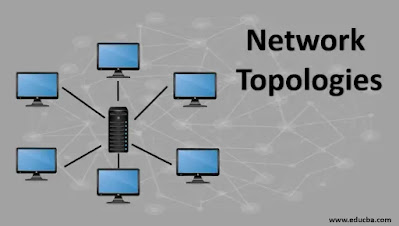Telecommunication Network Topologies.
The wiring scheme of a local area network is called topologies.
There are two simplest are point-to-point lines and multi-drop lines. point-to-point lines are used, when each terminal is connected by its own line to a computer system. multidrop lines are used when several terminals share each data communication line with a computer. Point-to-point lines are more expensive than Multidrop lines. All of the communication capacity and equipment of a communication line are being used by a single terminal. therefore point-to-point are used and a terminal or other computer system. A multidrop line decreases communication costs because each line is shared by many terminals.
Types of topologies.
there are three types of topology
- bus topology
- star topology
- ring topology
Bus topology
A topology that connects each computer, or station, the medium is a central wire called a bus.
there is a terminator at each end of the bus. if a computer wants to send data to another computer in the network, it sends the data and destination address via the bus.
this data and address move from one end of the network to the other. each computer checks this address and if it matches with this computer, the computer keeps the data, otherwise, the data move to the next. Transport geography is an organization type in which each PC and organization gadget is associated with a solitary link. It sends the information starting with one end then onto the next in a solitary bearing. No bi-directional element is in transport geography. It is a multi-point association and a non-powerful geography since, supposing that the spine bombs the geography crashes. In Transport Geography, different Macintosh (Media Access Control) conventions are trailed by LAN ethernet associations like TDMA, Unadulterated Salud, CDMA, Opened Salaam, and so forth
ADVANTAGE
- Simple, easy to used, and suitable for a very small network.
- The least amount of cable is required to connect the computers so it is less expensive .'
- Easy to extend a bus two cables can be joined with a connector.
- Allowing more computers to join the network.
DISADVANTAGE
- Heavy network traffic can slow a bus.
- Each connector reduces the strength of the electrical signal.
- A cable break or loose connector will cause to stop entire network
- As the number of computer increase, the speed of the network slows down.
STAR TOPOLOGY
in the star topology, cable from each computer is connected to a centralized device called a hub or switch,, signals are transmitted from the sending computer through the hub to all computer networks. In star geography, every one of the gadgets are associated with a solitary center through a link. This center point is the focal hub and any remaining hubs are associated with the focal hub. The center can be uninvolved in nature i.e., not a wise center, for example, communicating gadgets, simultaneously the center can be clever known as a functioning center point. Dynamic center points have repeaters in them. Coaxial link or RJ-45 links are utilized to interface the PCs. In Star Geography, numerous famous Ethernet LAN conventions are utilized as CD(Collision Discovery), CSMA (Transporter Sense Different Access), and so forth
if two computer wants to share data, the sender computer sends the data and the receiver computer reactive the data from the sender, A hub provides a central connection point to that all computer can communicate across the network.
it is more expensive than bus topology because it required more cabling than the bus and as well as the extra cost of the hub.
A single workstation failure does not create a problem but if HUB is fail the entire network will stop working.
ADVANTAGE
- it is easy to modify and add a new computer to start a network.
- Hub can accommodate multiple cable types.
- Finding fault becomes very simple.
- Single computer failure does not bring down the whole network.
DISADVANTAGE
- if the central hub fails, the entire network breakdown.
- it is more expensive.
`
RING TOPOLOGY
in this topology, all workstations are attached to each other in a circular wiring arrangement. in this topology, a token travels around the ring. A token is a message, that a workstation can send to any computer in the ring. Each retransmission is what it receives from the gracious computer. the message flow in one direction if the cable is broken then all computer will not function. In this geography, it frames a ring interfacing gadgets with precisely two adjoining gadgets.
Various repeaters are utilized for Ring geography with countless hubs, since, in such a case that somebody needs to send an information to the last hub in the ring geography with 100 hubs, then, at that point, the information should go through 99 hubs to arrive at the 100th hub. Thus to forestall information misfortune repeaters are utilized in the organization.
The information streams in a single course, i.e.., it is unidirectional, yet it tends to be made bidirectional by having 2 associations between each Organization Hub, it is called Double Ring Geography. In-Ring Geography, the Symbolic Ring Passing convention is utilized by the workstations to communicate the information
ADVANTAGE
- because every computer is given equal access to the token.
DISADVANTAGE
- Failure of one computer on this can affect the whole network.
- Difficult to troubleshoot.
- Adding or removing a computer disrupts the network.



